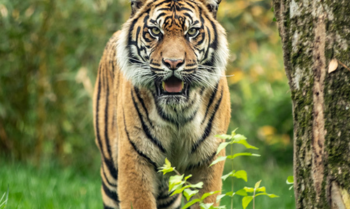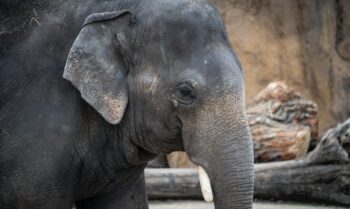June 3, 2024
Indicators of Success
How Denver Zoo Uses Indicator Species to Inform Global Conservation Strategy
The American pika, a tiny rabbit relative that inhabits high-alpine environments west of the Rocky Mountains, is notoriously difficult to see. Great for the pika; not so great for spotters. The trick, say community scientists working with the Colorado Pika Project, is to track their signature vocalization—a high-pitched “EEP”—then scan the source of the sound for slight movement.
A long-term collaboration between Denver Zoo and Rocky Mountain Wild, the Colorado Pika Project engages more than 400 passionate volunteers in seasonal pika patrols. Why? Like the polar bear, these pint-sized puffs are indicator species—which means they have a BIG story to tell about climate change.

Disappearance by Degrees
With a resting body temperature of 104 degrees Farenheit, American pika (Ochotona princeps) are both cold adapted and highly heat sensitive, thriving at high-alpine altitudes since the Pliocene era more than five million years ago. But as global temperatures rise, extreme swings threaten the pika’s survival at both ends of the spectrum. Rising temperatures can lead to heatstroke, while reduced snowfall affects the insulation of their stony talus homes—paradoxically, putting them at risk of freezing.
While Rocky Mountain pika populations appear stable, the species has been disappearing from the Great Basin and Sierra Nevada at an alarming rate. With the help of its dedicated Pika Patrollers, the Colorado Pika Project conducts regular surveys of local populations, using these data to track the impact of climate change on the species…and the ecosystem that supports them.
IMPERILED FROGS IN PERU
In Colorado, our pika work serves as an early warning system for climate effects on alpine ecosystems. But nearly 5,000 miles away, in the remote Andean wilderness, our research on two other indicator species has been informing our work since 2008.
Both the Titicaca water frog and Lake Junín frog, endemic to their namesake lakes, are categorized as Endangered by the International Union for the Conservation of Nature. Given the location of these lakes—in the tropical Andes mountains, one of the most ecologically rich regions in the world—the implications of their decline are dire.

Data-Driven Dedication
When Denver Zoo began our Peruvian Field Conservation work in 2008, we started with research to understand the unique challenges these species were facing. Our team found that both frogs were facing three main threats: pollution and water fluctuation caused by nearby mines, dams and human populations; illegal poaching for human consumption, as part of a traditional delicacy; and disease, particularly the infectious fungus responsible for amphibian population declines on a global scale, chytrid.
Complex challenges, of course, demand detailed solutions. In order to influence long-term change, we must support our wildlife work with a spectrum of holistic conservation efforts in the communities we serve. Here’s a quick overview of our multi-pronged approach.
Helping Endangered Frogs Bounce Back
RESEARCH: Our ongoing conservation efforts involve working with our Peruvian colleagues to develop and implement training programs to monitor frog population trends due to increasing anthropogenic (human-caused) pressures—as well as foundational studies on the chytrid fungus.
OUTREACH: We work with multiple partners to raise awareness with a variety of local and global outreach campaigns and events—from World Frog Day and related species awareness day events to Frog Guardians community science volunteers to high-profile media campaigns and more.
CAPACITY STRENGTHENING: To be successful in the long term, any conservation strategy needs to ensure there is sufficient capacity to support it. Denver Zoo worked with local partners to co-author the first-ever published conservation strategies for Lake Titicaca and Junín frogs.
These strategies included our support of student research at Cayetano Heredia Peruvian University, ranger training for Titicaca National Reserve and Junín National Reserve staff and more—as well as the founding of a women’s collective in Puno, on the shores of Lake Titicaca. Ccori Ampara makes a variety of frog-related handicrafts which they sell to community members and tourists, spreading awareness to their communities gaining supplemental income.
Making Our Success Scalable
For much of the 20th century, coal miners used caged canaries to measure the health of their working environment. While today, we have electronic detectors to do the dirty work underground, above the surface we still rely on animals to tell us how certain ecosystems are faring. Collecting data on indicator species is often a critical first step to developing long-term conservation strategies and Nature-Based Solutions that are holistic, successful—and ultimately, scalable.
To get involved in the Pika Patrol and our other Community Science projects, click HERE. For updates on our conservation work, follow us on Facebook, Instagram, X and LinkedIn. And finally, make sure you swing by Tropical Discovery on your next visit, where you’ll find our active Titicaca water frog army wriggling about in their tank!
Subscribe
Be first to hear the latest animal updates, important stories and details about all the fun happening around Denver Zoo.
Tags
-
 June 3, 2024
June 3, 2024The Leuser Wins
The Leuser Wins Denver Zoo and Forum Konservasi Leuser Join Forcesto Save Indonesia's Most Endangered Species When developing and…
-
 May 22, 2024
May 22, 2024Come Say G’Day | Down Under Now Open
COME SAY G'DAY Explore Down Under with Marvelous Marsupials and Other Species Native to Australia and Surrounding Regions Down…
-
 April 15, 2024
April 15, 2024Good Luck, Chuck!
Good Luck, Chuck! Beloved Bachelor Relocating as Part of Asian Elephant Species Survival Plan In a heartfelt and collaborative…

